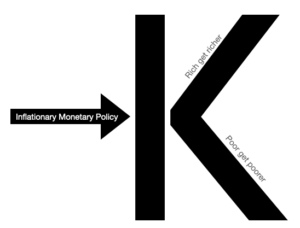
In Part 1 of this post, we examined the facts concluding that inflation is caused by monetary debasement. In this follow up, we’ll observe the reason behind why common belief is that inflation is at 3% – 5%. First, let’s recap what was already covered:
What is Inflation?
Inflation is the steady, continual rise in the price of goods. It is typically measured using a “basket of goods”. In this approach, the prices of many different goods are tracked and then integrated using some sort of logical weighting calculation.
What causes inflation?
In most developed countries, money is created by a central banking system. In the US, our central banking system is that of the Federal Reserve, a private bank. Money can be created by the Federal Reserve depositing newly created money into its member banks in exchange for US bonds. This increases the amount of money in existence. Additionally, every bank in the US has the ability to lend out 7 to 11 times as many dollars as it has in deposits. This also increases the amount of money in existence. With an increased money supply, prices rise. A continually increasing money supply, aka monetary debasement, causes inflation.
What is the current rate of inflation?
This is where there is a difference of opinion. For decades, inflation has been estimated using a “basket of goods” approach. In this method the price of each of a variety of goods is tracked, a logical weighting is applied, and the output is the rate of inflation, usually annualized. Under this method we can see inflation swinging up and down through economic cycles. In the early 1980’s, this data shows inflation at nearly 15% per annum. This is based on the published figures of the US Bureau of Labor Statistics.
In the early 1990’s the methodology of inflation reporting changed drastically, thus rendering the BLS “official” figures virtually useless. Unfortunately, these BLS figures continue to be used as if they were accurate.
A change in calculation method
Around 1993, Alan Greenspan argued that there was a flaw in the inflation calculation. He said that if the price of steak jumped up rapidly, then Americans would start eating hamburgers instead. For this reason, he proposed that when the price of something rises sharply we should reduce its weighting so that it isn’t proportionately reflected in the output inflation figure. This is basically a “substitution adjustment”. Once this change was put into practice, the BLS inflation figure no longer represented the rising costs of maintaining a standard of living… it instead represents the rising costs of maintaining a declining standard of living.
If I’m eating steak one month and hamburger the next, my quality of life has declined. To accurately examine inflation, I need to know what it will cost for me to continue eating steak. This is especially relevant when considering the rapidly rising price of gasoline. Because of the powerful energy monopoly, we don’t have a realistic way to immediately substitute something else in the place of gasoline. We can’t all just start putting pond water in our cars and still get around town.
Since this change in methodology, BLS has been reporting inflation at around 2% – 5%… even through the economic cycles of the past decade. For the first time ever it appears (to the naive person) that we’ve conquered the laws of economics. Other independent economists have been estimating inflation using the methodology prior to the substitution change. Using the same calculation methods from the 80’s yields a current estimate of inflation approaching 12%. It appears that the “substitution” method consistently understated inflation by about 7%. In other words, post-1993 BLS figures have been misreported by up to 200%.
Misreporting helps to balance the budget
It’s also important to note that the government’s finances unquestionably have been a growing mess. With its debt rising much faster than income, it’s on a one-way path to bankruptcy, and there’s not a single person on the planet who can convincingly argue otherwise. Anything it can do to minimize expenses will help to defer its financial reality. A side effect of this misreporting is that social security payouts are raised using the understated BLS inflation figures. This helps to lower government expenses and lessen the deficit.
Inflation Foreshadowing
With monetary debasement (an increasing money supply) as the primary cause of inflation, one can look at the money supply itself to see which direction inflation is heading. Another problem lies herein. The Federal Reserve stopped publishing its “M3” data about the money supply in 2006. It’s last M3 report indicated a money supply growing at about 8% per year. Since this decision, we’ve been left searching for data published by independent economists that attempts to continue to M3 growth estimation. Current figures provide M3 growth of 16% per year. This suggests that the rate of inflation is likely to continue to rise.
Ahhhh… the sky is falling!
Relax. What’s more important than the national economy is your personal economy. Our economic environment offers a multitude of opportunities to profit, especially with all the rapid changes taking place today. A good starting point is the following two books:

![Crash Proof [by Peter D. Schiff]](http://www.nabersgroup.com/docs/regulus/crash_proof.jpg)


